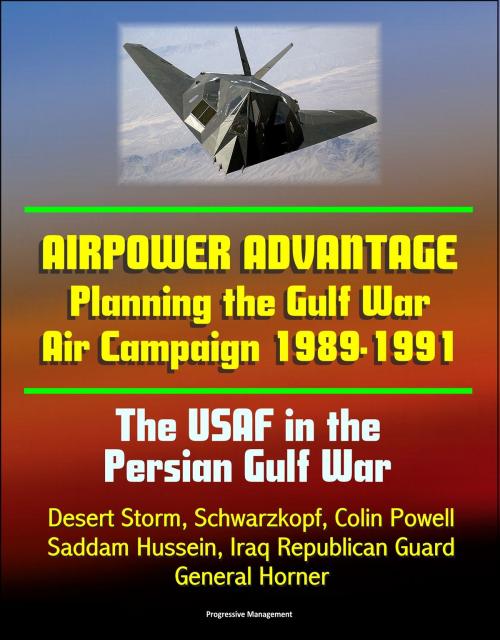The USAF in the Persian Gulf War: Airpower Advantage - Planning the Gulf War Air Campaign 1989-1991, Desert Storm, Schwarzkopf, Colin Powell, Saddam Hussein, Iraq Republican Guard, General Horner
Nonfiction, History, Middle East, Persian Gulf War, Military, Aviation| Author: | Progressive Management | ISBN: | 9781310694431 |
| Publisher: | Progressive Management | Publication: | January 18, 2015 |
| Imprint: | Smashwords Edition | Language: | English |
| Author: | Progressive Management |
| ISBN: | 9781310694431 |
| Publisher: | Progressive Management |
| Publication: | January 18, 2015 |
| Imprint: | Smashwords Edition |
| Language: | English |
American air power is a dominant force in today's world. Its ascendancy, evolving in the half century since the end of World War II, became evident during the first Gulf War. Although a great deal has been written about military operations in Desert Shield and Desert Storm, this deeply researched volume by Dr. Diane Putney probes the little-known story of how the Gulf War air campaign plan came to fruition. Based on archival documentation and interviews with USAF planners, this work takes the reader into the planning cells where the difficult work of building an air campaign plan was accomplished on an around-the-clock basis. The tension among air planners is palpable as Dr. Putney traces the incremental progress and friction along the way.
The author places the complexities of the planning process within the context of coalition objectives. All the major players are here: President George H. W. Bush, General H. Norman Schwarzkopf, General Colin Powell, General Chuck Horner, and Secretary of Defense Richard Cheney. The air planning process generated much debate and friction, but resulted in great success — a 43-day conflict with minimum casualties. Dr. Putney's rendering of this behind-the-scenes evolution of the planning process, in its complexity and even suspense, provides a fascinating window into how wars are planned and fought today and what might be the implications for the future.
Chapter 1 - OPLAN 1002-90 * Chapter 2 - Instant Thunder * Chapter 3 - Desert Storm Phase I * Chapter 4 - Desert Shield Planning * Chapter 5 - JFACC and Instant Thunder * Chapter 6 - Special Planning Group * Chapter 7 - Phase I Triumphant * Chapter 8 - Phases II, III, and IV * Chapter 9 - Problems and Solutions
Planning air campaigns is crucially important to airmen, notably to those planning the 1991 Desert Storm campaign. Their air plan emerged, expanded, and evolved as individuals from Florida and South Carolina military bases, from Saudi Arabia, the Pentagon, and the White House all contributed to the process. That the officers responsible for crafting the Gulf War air plan found the ordeal to be arduous, complicated, and contentious is undeniable, but we have now a documented, close look at the collaborative, intellectual effort that went into producing their war plan. Although planning is seemingly less exciting than combat, the Desert Storm undertaking included strong-willed officers, bold thinking, and the clash and melding of ideas. Planners knew that if their ideas were not sound and shrewd, they doomed the pilots and the war's outcome. Many key participants generously shared their experiences, and their vivid words enliven this account.
When Iraq invaded Kuwait in August 1990, the unified combatant command responsible for Southwest Asia, the U.S. Central Command, had no offensive plan ready to execute in response to Iraqi aggression. The U.S. Central Command Commander, General H. Norman Schwarzkopf, USA, directed and participated in the offensive planning process that lasted throughout Desert Shield and continued even as the air war commenced on January 17, 1991. He described the enterprise: "It is a tortuous process coming up with the decisions that involve the lives of hundreds of thousands of people. It's not simple. . . . You agonize over your decisions. You agonize over your plan." Because the Central Command commander would execute air operations in all phases of his offensive plan, the air campaign was the dominant feature in the Gulf War of 1991. As early as August 25, 1990, the basic framework of the war plan had emerged, with Phase I, Strategic Air Campaign; Phase II, Air Supremacy in Kuwait; Phase III, Attrition of Ground Combat Power (later, Preparation of the Battlefield); and Phase IV, Ground Attack.
American air power is a dominant force in today's world. Its ascendancy, evolving in the half century since the end of World War II, became evident during the first Gulf War. Although a great deal has been written about military operations in Desert Shield and Desert Storm, this deeply researched volume by Dr. Diane Putney probes the little-known story of how the Gulf War air campaign plan came to fruition. Based on archival documentation and interviews with USAF planners, this work takes the reader into the planning cells where the difficult work of building an air campaign plan was accomplished on an around-the-clock basis. The tension among air planners is palpable as Dr. Putney traces the incremental progress and friction along the way.
The author places the complexities of the planning process within the context of coalition objectives. All the major players are here: President George H. W. Bush, General H. Norman Schwarzkopf, General Colin Powell, General Chuck Horner, and Secretary of Defense Richard Cheney. The air planning process generated much debate and friction, but resulted in great success — a 43-day conflict with minimum casualties. Dr. Putney's rendering of this behind-the-scenes evolution of the planning process, in its complexity and even suspense, provides a fascinating window into how wars are planned and fought today and what might be the implications for the future.
Chapter 1 - OPLAN 1002-90 * Chapter 2 - Instant Thunder * Chapter 3 - Desert Storm Phase I * Chapter 4 - Desert Shield Planning * Chapter 5 - JFACC and Instant Thunder * Chapter 6 - Special Planning Group * Chapter 7 - Phase I Triumphant * Chapter 8 - Phases II, III, and IV * Chapter 9 - Problems and Solutions
Planning air campaigns is crucially important to airmen, notably to those planning the 1991 Desert Storm campaign. Their air plan emerged, expanded, and evolved as individuals from Florida and South Carolina military bases, from Saudi Arabia, the Pentagon, and the White House all contributed to the process. That the officers responsible for crafting the Gulf War air plan found the ordeal to be arduous, complicated, and contentious is undeniable, but we have now a documented, close look at the collaborative, intellectual effort that went into producing their war plan. Although planning is seemingly less exciting than combat, the Desert Storm undertaking included strong-willed officers, bold thinking, and the clash and melding of ideas. Planners knew that if their ideas were not sound and shrewd, they doomed the pilots and the war's outcome. Many key participants generously shared their experiences, and their vivid words enliven this account.
When Iraq invaded Kuwait in August 1990, the unified combatant command responsible for Southwest Asia, the U.S. Central Command, had no offensive plan ready to execute in response to Iraqi aggression. The U.S. Central Command Commander, General H. Norman Schwarzkopf, USA, directed and participated in the offensive planning process that lasted throughout Desert Shield and continued even as the air war commenced on January 17, 1991. He described the enterprise: "It is a tortuous process coming up with the decisions that involve the lives of hundreds of thousands of people. It's not simple. . . . You agonize over your decisions. You agonize over your plan." Because the Central Command commander would execute air operations in all phases of his offensive plan, the air campaign was the dominant feature in the Gulf War of 1991. As early as August 25, 1990, the basic framework of the war plan had emerged, with Phase I, Strategic Air Campaign; Phase II, Air Supremacy in Kuwait; Phase III, Attrition of Ground Combat Power (later, Preparation of the Battlefield); and Phase IV, Ground Attack.















